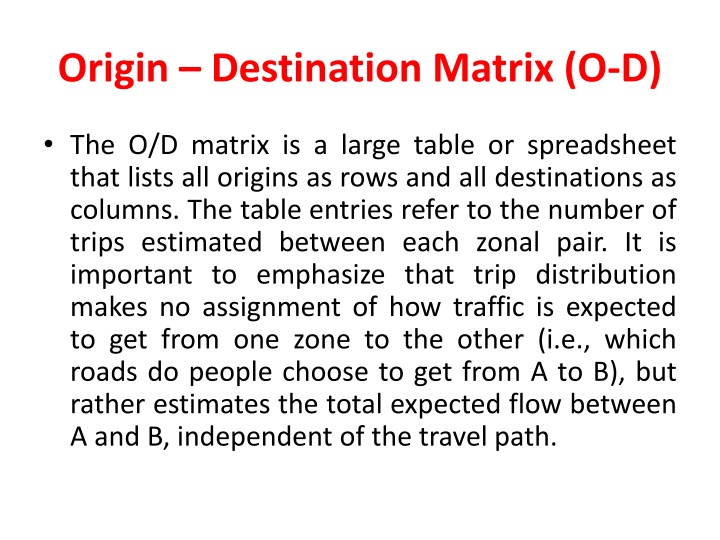
Origin-Destination Matrix in Traffic Analysis
Explore the significance of Origin-Destination (O-D) matrix in transportation planning, different types of surveys used to collect trip data, and methods such as household surveys, O-D surveys, roadside interviews, and cordon and screen-line surveys. These surveys help estimate the flow of traffic between various zones and provide essential data for traffic management strategies.
Download Presentation

Please find below an Image/Link to download the presentation.
The content on the website is provided AS IS for your information and personal use only. It may not be sold, licensed, or shared on other websites without obtaining consent from the author. If you encounter any issues during the download, it is possible that the publisher has removed the file from their server.
You are allowed to download the files provided on this website for personal or commercial use, subject to the condition that they are used lawfully. All files are the property of their respective owners.
The content on the website is provided AS IS for your information and personal use only. It may not be sold, licensed, or shared on other websites without obtaining consent from the author.
E N D
Presentation Transcript
Origin Destination Matrix (O-D) The O/D matrix is a large table or spreadsheet that lists all origins as rows and all destinations as columns. The table entries refer to the number of trips estimated between each zonal pair. It is important to emphasize that trip distribution makes no assignment of how traffic is expected to get from one zone to the other (i.e., which roads do people choose to get from A to B), but rather estimates the total expected flow between A and B, independent of the travel path.
Types of Surveys The objective of the survey is primarily to collect the origin and destination trip zones and for this many suitable methods can be adopted. 1- Household surveys Trips made by all household members by all modes of transport both within the study area and leaving/arriving to the area during the survey period; this survey should include socioeconomic information (income, car ownership, family size and structure, etc.).
2- O-D survey The Origin-Destination contains information about traffic flow values between all pairs of centroids 3- Roadside interviews These provide trips not registered in a household survey, especially external-internal trips. This involves asking questions to a sample of drivers and passengers of vehicles crossing a particular location. But it should be noted that at road-side, drivers will not be willing to spend much time for a survey. matrix (O-D matrix)
4- Cordon and screen-line survey These provide useful information about external external and external internal trips. Their objective is to determine the number of trips that enter, leave and/or cross the cordoned area, thus helping to complete the information household O D survey data on people crossing the study area border, particularly nonresidents of the study area. This provides useful information about trips from and to external zones. For large study area, internal cordon line surveying can be conducted. It could be either recording the license plate number at all the external cordon points or by post-card method. coming from the






















